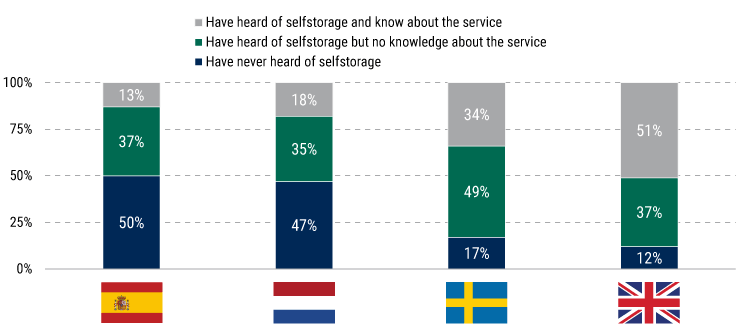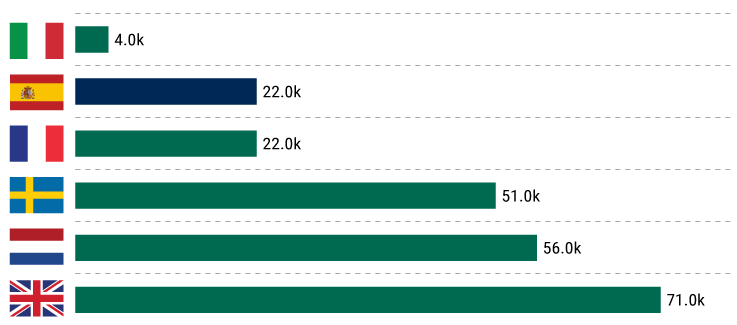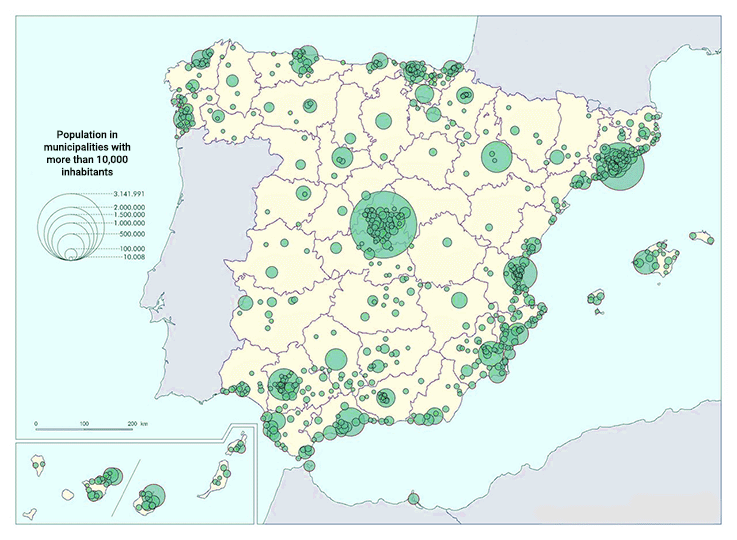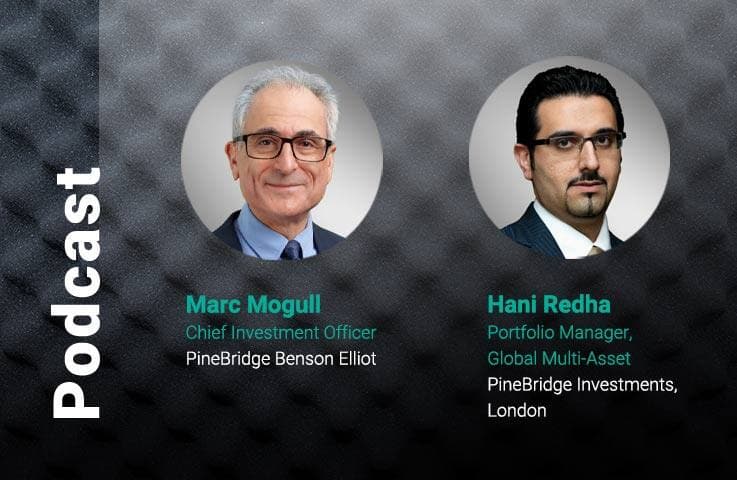How Self-Storage and Spain Became Unlikely Growth Partners

Self-storage, a relatively simple category of real estate just a notch or two up from parking lots, has become a hot property in the pandemic/post-pandemic era. As people retreated into their homes, first they needed somewhere to store their excess belongings to make room for remote offices, workout areas, and impromptu daycare centers. Then, after re-opening, they used the same storage units to stash the standing desks, fancy exercise bikes, and inflatable bouncy castles no longer seeing regular use. From the end of February 2020, just before the pandemic sank markets, through the end of 2021, self-storage shares in the FTSE All Equity US REITs Index returned 84%, compared to 20% for the broader real estate investment trust index1. A similar pattern was seen in Europe’s most mature self-storage market, the UK.
Though the surge has since cooled, the market caps of publicly held self-storage companies are still up more than 20% on average relative to their pre-pandemic highs2 — hardly the case for more traditionally institutional classes within real estate. The fact remains: Even as some of the built world is currently discounted in favor of the virtual, people still take up a certain amount of physical space, and periodically have the need for a convenient but out-of-the-way spot to absorb their overfill.
Interestingly (and not surprisingly), one of the most attractive self-storage markets today is one of the least penetrated. In Spain, where self-storage was barely a commercial construct until last decade, choice locations now boast a projected yield on cost (YoC) of 15%3 at the property level. Even considering the corporate overhead for self-storage — not inconsiderable given the intensive marketing and coordination involved in operating a dispersed property network catering to a granular customer base — the enterprise-level YoC for Spanish self-storage tops 11%.3
Self- What Was That Again?
Self storage awareness in Spain vs. Europe

2022 Self-storage sqm per million capita

Source: FEDESSA Industry report 2022. For illustrative purposes only
To put that in perspective, we recently wrote about European logistics and light industrial warehouses, another growth segment-turned pocket of opportunity in the topsy-turvy post-pandemic, post-low interest rate, post-green transition commercial real estate (CRE) environment. A healthy YoC for such “shed” projects is about 7%4. So, the prospective yield-on-cost for Spanish self-storage is about 1.5x higher than one of the next richest available in the market.
Build it and they will come
Many who follow and invest in commercial real estate often think about new market opportunities as being demand-driven. Ecommerce and third-party logistics (3PL) providers need more space, so more warehouses are built. Corporate tenants begin demanding buildings with lower carbon footprints and higher energy efficiency, so more new offices begin to be built to stricter sustainability standards. But sometimes supply is the big driver due to a neglected latent demand: Tenants can’t access (or don’t realize they have need for) a certain product until it becomes available. Then once it’s there, they can’t get enough of it.
In retrospect, the seeds of Spain’s latent self-storage demand were probably planted decades ago. Spain’s population has long had among the least amount of closet space of anywhere in Europe. The pattern dates to the mass urban migration which began in the 1960s, when as part of a larger agenda to instill higher levels of civic responsibility, the government of dictator Francisco Franco implemented sweeping reforms encouraging home ownership. Because it was so much cheaper to build taller multi-unit dwellings than single family homes, most of the new homes that went up were apartments, particularly in the large urban centers of Barcelona and Madrid. Today, Spain is among the most urbanized societies on earth, with Europe’s highest percentage of elevators per capita5, and largest percentage of the population living in flats (42.7%) of any country other than Estonia 6.
Spain’s Population Is Notably Urban
Population density in Spain

Source: Instituto Geografico Nacional de Espana. For illustrative purposes only
Spain’s population has traditionally spent more of its disposable income taking advantage of the nice weather by gathering in outdoor cafes and bars than by accumulating stuff. However, with the rise in incomes and the affordability of goods following the establishment of the European common market, consumer spending has picked up over the past couple of decades. With more widespread adoption of family planning and a related decline in average household size, the average apartment has also shrunk. Even with fewer children per household, this downsizing translates into even less storage per cubic meter for baby clothes, old books, and sentimental pieces of furniture. Nevertheless, when families need a place to put the spillover, most would try to find a friend with a garage or undergo the painful exercise of purging and throwing stuff to the bin. “Self-storage” in the organized, commercial Public Storage or Big Yellow sense of the term largely remained a foreign concept.
The catalyst came with the bursting of the 2005-2008 property bubble and the enormous overhang of vacant properties in Spain in its aftermath. To this day, in many neighborhoods in the major cities, streets just a block or two off the main shopping throughfare may have stores that have been sitting empty for years. Obsolete industrial sites loom forlornly on the edges of residential areas while “brown” offices, ill-equipped for sustainability hang half-empty in limbo. A number of entrepreneurs with some self-storage knowledge and vacant properties, lacking an alternative viable use started converting them to self-storage facilities. And lo and behold: It worked.
Once self-storage facilities became available, more types of customers began to come out of the woodwork. Spain has among Europe’s largest and fastest-growing population of small and medium enterprises and freelancers. As in other markets, independent workers and tradespeople have come to realize it is often more economical and convenient to place stock in a self-storage unit, while working from home, than to rent a larger warehouse or office space. Then the pandemic hit and acted as a giant accelerant. Trapped in flats and spending more of their time and money online ordering packages, the Spanish experienced a growing sense of claustrophobia – in a similar way to other nations but with one major difference: the amount of self-storage per person in the country was still about 40 times less than in the US.4 As a result, the number of occupied new units has almost doubled.7 And rents have been steadily growing at 1.5%8 per year even with increasing supply.
For example, one of the largest self-storage networks only started in the last decade but has grown to 80+ stores in only a small number of years. This company has established a highly capital-efficient and repeatable model for opening new locations. Once a derelict property is acquired, the company takes a spartan and cost-efficient approach to converting it – taking on average ten months to get it ready for business. That’s about half as long as typical for operators that erect new facilities from scratch, given their more demanding permitting process and naturally lengthier construction time. In addition, the amount of embodied carbon created (a factor of increasing importance under the EU’s tightening carbon standards) is also much more limited with “renovated” old than with new builds. After all, the least polluting structure is the one you don’t build.
Once it is open, operating costs are likewise relatively low. Not only are all the lighting fixtures typically high-efficiency LED; they don’t even come on unless the motion sensors detect activity. And heating and air conditioning? These are mostly nonexistent, as few clients need temperature control (though that is an emerging sub-segment with its own bright outlook). As a result, storage units can get a little toasty on a typical midsummer day in Madrid, but for most clients (and their old couches), this isn’t a problem.
Round and round it goes
Higher prospective rates of return come with higher levels of risk, and Spanish self-storage is no exception. While the operation of a Spanish self-storage facility may be bare bones, it’s hard work and requires significant economies of scale, resourcing, and know-how to do it right. To keep the dozens to hundreds of units in each facility filled requires constant marketing, rent specials, and dynamic pricing. Many self-storage customers end up spending more on self-storage fees than the value of items stored. Still, there’s always a certain percentage of customers who eventually cut off billing access to their credit card and leave it to the management to get around to hauling their once-cherished belongings to the dumpster. Managed tightly, a Spanish self-storage facility has the potential to be a veritable profit machine. Run with any less rigor, it can also leave a lot of money on the table.
There is another challenge as well: In Spain, the market is so new, the country’s largest banks do not recognize self-storage as its own category in their lending frameworks yet. That means securing favorable financing for self-storage development can be difficult and slow. Generally, the only parties able to move fast enough to take advantage of the rapidly evolving market have been those with sufficient discretionary funds to invest. Like any other property investment, self-storage in Spain is capital intensive.
On the positive side, each of these frictions creates barriers to entry for what could otherwise be a highly commoditized product. Could a major market participant come in with a lot of its own capital and take market share? No question. But they’d also have to be up for the grind and come armed with boots on the ground and very sector-specific expertise.
Based on the experience in Spain, some investors are now looking to leverage these learnings for the next great high-yield-on-cost European self-storage opportunity. One market receiving a close look is France. There, the market is also undersupplied and more concentrated: nonetheless, lenders in France have already recognized self-storage as a lending category, which helps reduce the overall cost of capital.
Within Spain, some operators have also found an interesting way to expand the traditional definition of a self-storage customer and to further diversify their customer base. In addition to its standard segments of flat dwellers and freelancers, leaders in the space have made a large and stable business of leasing units to sticky corporate clients for ultra-last mile logistics. These include sales forces, and pharmaceutical distributors, as well as 3PLs.
Since the dawn of the e-commerce boom, companies have struggled to find the most efficient solution to the “last mile” problem of transferring packages from large outlying distribution centers to smaller in-town facilities for street-level deliveries. Building out a large-enough network of dedicated last-mile facilities in a teeming metropolis such as Madrid can be a major undertaking—and is no longer necessary when rows of newly installed self-storage lockers can work just as well for all parties concerned.
It’s yet another twist in the ongoing transformation in parts of the European commercial real estate market. At a time when some former class-A offices and malls are being written down below replacement costs, derelict bricks-and-mortar properties in urban infill locations are finding a new lease of life as self-storage-cum-mini-last-mile-facilities, portions of which facilitate the buying of more stuff online that someday will … likely end up right back in self-storage.
Disclosure
Investing involves risk, including possible loss of principal. The information presented herein is for illustrative purposes only and should not be considered reflective of any particular security, strategy, or investment product. It represents a general assessment of the markets at a specific time and is not a guarantee of future performance results or market movement. This material does not constitute investment, financial, legal, tax, or other advice; investment research or a product of any research department; an offer to sell, or the solicitation of an offer to purchase any security or interest in a fund; or a recommendation for any investment product or strategy. PineBridge Investments is not soliciting or recommending any action based on information in this document. Any opinions, projections, or forward-looking statements expressed herein are solely those of the author, may differ from the views or opinions expressed by other areas of PineBridge Investments, and are only for general informational purposes as of the date indicated. Views may be based on third-party data that has not been independently verified. PineBridge Investments does not approve of or endorse any republication of this material. You are solely responsible for deciding whether any investment product or strategy is appropriate for you based upon your investment goals, financial situation and tolerance for risk.
Footnotes
1 “Self-storage Is the Pandemic’s Hot Property,” The Wall Street Journal (22 December, 2021).
2 Based on Bloomberg data for self-storage index comprised of Public Storage, Extra Space Storage, Cubesmart, Life Storage, National Storage Affiliates, Big Yellow, Safestore, Shurgard as of October 2023.
3 Source: PineBridge research and calculations as of October 2023, based on latest available company accounts. Yield on cost is a simple but effective metric commonly used to calculate the projected rate of return on a property, in which: Yield = Total Net Operating Income Generated / Total Cost (including Acquisition, Development, and all Property level Operational-Related Expenses).
4 Source: DTRE Research: Big Box Logistics, Occupier & Investment Market Review Q1 2023
5 “Why Does Spain the World’s Highest Concentration of Elevators?,” The Atlantic and Quartz (October 9, 2014).
6 “Distribution of population by degree of urbanisation, dwelling type and income group - EU-SILC survey” Eurostat.
7 FEDESSA European Self Storage Annual Survey 2017 and 2022.
8 FEDESSA European Self Storage Annual Survey 2017 and 2022.




